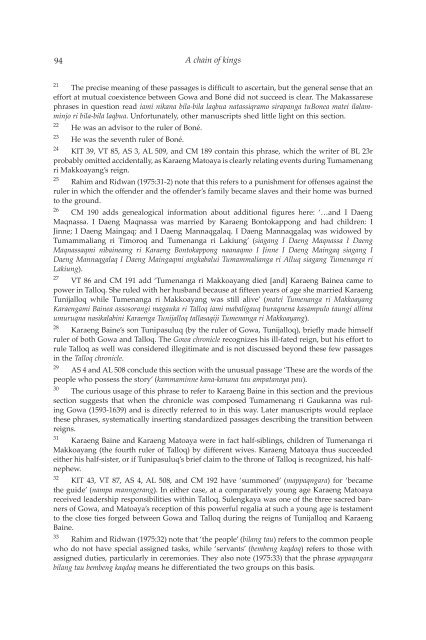A CHAIN OF KINGS - Books and Journals
A CHAIN OF KINGS - Books and Journals
A CHAIN OF KINGS - Books and Journals
You also want an ePaper? Increase the reach of your titles
YUMPU automatically turns print PDFs into web optimized ePapers that Google loves.
94<br />
A chain of kings<br />
21 The precise meaning of these passages is difficult to ascertain, but the general sense that an<br />
effort at mutual coexistence between Gowa <strong>and</strong> Boné did not succeed is clear. The Makassarese<br />
phrases in question read iami nikana bila-bila laqbua natassiqramo sirapanga tuBonea matei ilalamminjo<br />
ri bila-bila laqbua. Unfortunately, other manuscripts shed little light on this section.<br />
22 He was an advisor to the ruler of Boné.<br />
23 He was the seventh ruler of Boné.<br />
24 KIT 39, VT 85, AS 3, AL 509, <strong>and</strong> CM 189 contain this phrase, which the writer of BL 23r<br />
probably omitted accidentally, as Karaeng Matoaya is clearly relating events during Tumamenang<br />
ri Makkoayang’s reign.<br />
25 Rahim <strong>and</strong> Ridwan (1975:31-2) note that this refers to a punishment for offenses against the<br />
ruler in which the offender <strong>and</strong> the offender’s family became slaves <strong>and</strong> their home was burned<br />
to the ground.<br />
26 CM 190 adds genealogical information about additional figures here: ‘…<strong>and</strong> I Daeng<br />
Maqnassa. I Daeng Maqnassa was married by Karaeng Bontokappong <strong>and</strong> had children: I<br />
Jinne; I Daeng Maingaq; <strong>and</strong> I Daeng Mannaqgalaq. I Daeng Mannaqgalaq was widowed by<br />
Tumammaliang ri Timoroq <strong>and</strong> Tumenanga ri Lakiung’ (siagang I Daeng Maqnassa I Daeng<br />
Maqnassaqmi nibaineang ri Karaeng Bontokappong naanaqmo I Jinne I Daeng Maingaq siagang I<br />
Daeng Mannaqgalaq I Daeng Maingaqmi angkabalui Tumammalianga ri Alluq siagang Tumenanga ri<br />
Lakiung).<br />
27 VT 86 <strong>and</strong> CM 191 add ‘Tumenanga ri Makkoayang died [<strong>and</strong>] Karaeng Bainea came to<br />
power in Talloq. She ruled with her husb<strong>and</strong> because at fifteen years of age she married Karaeng<br />
Tunijalloq while Tumenanga ri Makkoayang was still alive’ (matei Tumenanga ri Makkoayang<br />
Karaengami Bainea assosorangi magauka ri Talloq iami mabaligauq buraqnena kasampulo taungi allima<br />
umuruqna nasikalabini Karaenga Tunijalloq tallasaqiji Tumenanga ri Makkoayang).<br />
28 Karaeng Baine’s son Tunipasuluq (by the ruler of Gowa, Tunijalloq), briefly made himself<br />
ruler of both Gowa <strong>and</strong> Talloq. The Gowa chronicle recognizes his ill-fated reign, but his effort to<br />
rule Talloq as well was considered illegitimate <strong>and</strong> is not discussed beyond these few passages<br />
in the Talloq chronicle.<br />
29 AS 4 <strong>and</strong> AL 508 conclude this section with the unusual passage ‘These are the words of the<br />
people who possess the story’ (kammaminne kana-kanana tau ampatanaya pau).<br />
30 The curious usage of this phrase to refer to Karaeng Baine in this section <strong>and</strong> the previous<br />
section suggests that when the chronicle was composed Tumamenang ri Gaukanna was ruling<br />
Gowa (1593-1639) <strong>and</strong> is directly referred to in this way. Later manuscripts would replace<br />
these phrases, systematically inserting st<strong>and</strong>ardized passages describing the transition between<br />
reigns.<br />
31 Karaeng Baine <strong>and</strong> Karaeng Matoaya were in fact half-siblings, children of Tumenanga ri<br />
Makkoayang (the fourth ruler of Talloq) by different wives. Karaeng Matoaya thus succeeded<br />
either his half-sister, or if Tunipasuluq’s brief claim to the throne of Talloq is recognized, his halfnephew.<br />
32 KIT 43, VT 87, AS 4, AL 508, <strong>and</strong> CM 192 have ‘summoned’ (mappaqngara) for ‘became<br />
the guide’ (nampa manngerang). In either case, at a comparatively young age Karaeng Matoaya<br />
received leadership responsibilities within Talloq. Sulengkaya was one of the three sacred banners<br />
of Gowa, <strong>and</strong> Matoaya’s reception of this powerful regalia at such a young age is testament<br />
to the close ties forged between Gowa <strong>and</strong> Talloq during the reigns of Tunijalloq <strong>and</strong> Karaeng<br />
Baine.<br />
33 Rahim <strong>and</strong> Ridwan (1975:32) note that ‘the people’ (bilang tau) refers to the common people<br />
who do not have special assigned tasks, while ‘servants’ (bembeng kaqdoq) refers to those with<br />
assigned duties, particularly in ceremonies. They also note (1975:33) that the phrase appaqngara<br />
bilang tau bembeng kaqdoq means he differentiated the two groups on this basis.









![Am HaSefer [Volk des Buches] - Books and Journals](https://img.yumpu.com/20648352/1/174x260/am-hasefer-volk-des-buches-books-and-journals.jpg?quality=85)







